With G/R Tron and Amulet Bloom meeting in the finals of the Season Two Invitational and another copy of each in the Top Eight, everyone is looking ahead to Grand Prix Charlotte and wondering how to gain an edge. For most people, this means getting off of Jund and finding a strategy that is naturally good against those decks, such as Splinter Twin.
For me, this just means that I know my enemy, which makes my job a lot easier.
The Season Two Invitational
I was well-practiced with Jund, mostly thanks to streaming a bunch, but ended up doing poorly in the Invitational. What happened?
Well, this was by far the worst Invitational performance I’ve ever had. There have been times where my decks were bad, but it was actually the opposite this time. Both my decks were great, but the pilot error was incredible this time. I ended up losing to Storm and G/W Collected Company in Modern, which are both decks I prepared for and had plans for, but I managed to turn possible wins into losses several times.
The best example of me playing poorly actually happened in the Modern Open the next day. I defeated Amulet Bloom in round one, threw away game two of the second round to Eternal Command, and found myself paired against G/W Hexproof in round three.
I mulliganed while on the play in game two, and my hand contained:
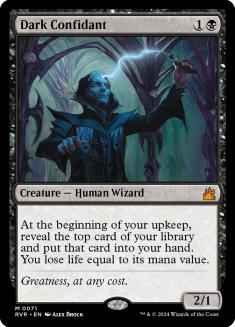
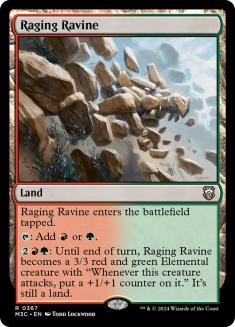

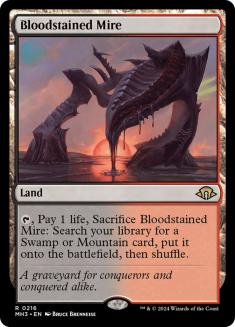
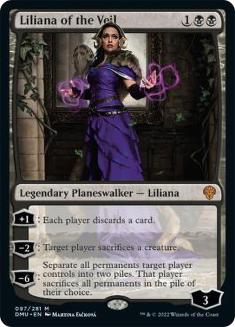

Raging Ravine was my first play, which I’m pretty sure is the only play you can realistically make. After my opponent slipped a Bogle into play, I played Swamp and Dark Confidant.
My opponent proceeded to play a turn-two Suppression Field, and after drawing another Bloodstained Mire I was unable to cast spells for the rest of what was an entirely-winnable game.
There is basically no excuse for what I did. Suppression Field is a widely-played card, it should have been on my radar, and my play on the entirety of the weekend felt like amateur hour. After a lackluster performance in the Invitational, I felt like I was ready to turn it all around for the Modern Open and failed miserably.
Despite being technically still in contention to win the tournament, I dropped, and I didn’t even bother to register for the Legacy Premier IQ on Sunday. It was just one of those weekends and there’s nothing else to do but try and do better next time.
Going Forward
As I said earlier, I fully expect Splinter Twin to be out in full force this weekend. Grixis Twin seems like the most popular flavor considering it put one player into the Top Eight of the Invitational and two players into Top Eight of the Modern Open. However, an old-school version with maindeck Blood Moons might be potent this weekend as well, especially since it has the possibility of OHKOing greedy mirror players who don’t play around it in game one. After that, you can happily sideboard it out and your opponents will have to fetch awkwardly trying to play around it. Jund will still likely be a big portion of the field and Blood Moon, as always, is quite good against them as well.
Burn continues to be a deck that players hate losing to, which contributes to Burn underperforming, so that doesn’t seem like a great choice either. Affinity and Infect seem poorly-positioned against a field of Jund, but both of those archetypes did well in the Modern Open. Shrug.
The State Of Modern
How matchups play out from the Jund side, especially these days, hinge on having as much cheap interaction as possible. I’m also not preparing for the same stuff as I did last week. Grixis Delver and Abzan Collected Company were both decks I expected last weekend, and they showed up but didn’t perform very well. Given that G/R Tron and Amulet Bloom are also not great matchups for those decks, I expect them to mostly disappear.
Be wary that Modern is far more than just the recent tournament winners though. If you audible to a deck that annihilates G/R Tron and Amulet Bloom, you’ll likely get destroyed by the other 90% of the field, so be careful. This tends to work both ways. You can also play a deck that is very bad against the deck that won the last tournament and still expect to dodge it. Perhaps I’m being too dismissive of certain decks given that information, but I still think it’s more likely than not that decks like Grixis Delver and Abzan Collected Company will fade away.
The other thing that I would stress is that land destruction is going to be a key aspect of having a reasonable matchup against G/R Tron and Amulet Bloom. It doesn’t solve all the problems, so you shouldn’t be upset when you lose even though your draw contains two Fulminator Mages, but it helps.
Ultimately there’s just more to those matchups than just killing their lands though.
The G/R Tron And Amulet Bloom Matchups
Winning game one against G/R Tron is nearly impossible with a normal Jund deck, which is why it’s so difficult for Jund to win matches against G/R Tron. Amulet Bloom is a little more manageable, but unlike with G/R Tron, things are reasonable for Jund in game one and get much better for Amulet Bloom after sideboard. The sideboard games are difficult enough already, so clinching both of those games against G/R Tron is by no means a guarantee. You basically need to have a shot in game one in order to win the match against G/R Tron, and between the five land destruction cards I will likely play, I think the matchup will be OK.
When you’re on the draw, having a three-mana land destruction spell is likely too slow, which is why I like Ghost Quarter. If you have a way to interact with their mana base, it will likely buy you two turns, so losing your land drop to Ghost Quarter will likely end up benefiting you. There’s also the possibility of turn-three Tarmogoyf + Ghost Quarter beatings that put you very far ahead.
Overall, Ghost Quarter has overperformed against G/R Tron and Amulet Bloom, but drawing a mix of disruption is generally best. If your draw only includes Fulminator Mages, it’s likely that you’ll be disrupting them but won’t be able to clock them. If your draw is only Ghost Quarters, you’re probably in the same scenario, just in a different way.
After sideboard, when you have access to more disruption, you want that disruption to actually count. I ran a pair of Blood Moons in my sideboard at the Invitational and didn’t regret it in the slightest. There are very few decks where I’d want more copies of Fulminator Mage, so having something that’s actually a haymaker is a big deal.
On the Modern Week of Standard Super League, my Blood Moons weren’t effective because my opponent had my decklist, which won’t necessarily be true at the Grand Prix. Also, I wasn’t able to draw a discard spell, which would have protected it and likely won me the game and the match.
The big lesson to learn in these matchups is that you can’t just slam a Blood Moon with no pressure and expect to win though. Eventually they’ll get to six mana and start hardcasting Wurmcoil Engines while you struggle to find one of your basic lands. Even with all the land destruction, you still need to be pressuring your opponents because eventually they’ll draw out of it.
There’s another lesson worth learning. Against Amulet Bloom, I was up a game and drew this opening hand:
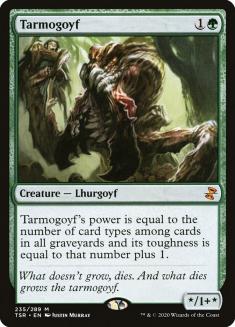
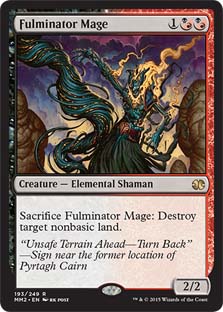
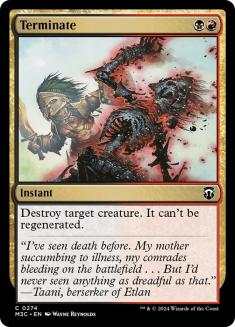
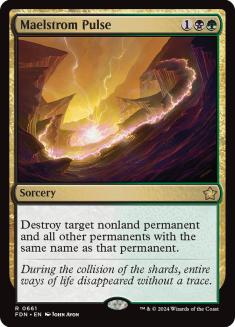

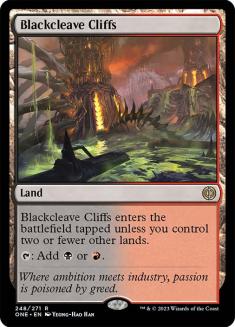
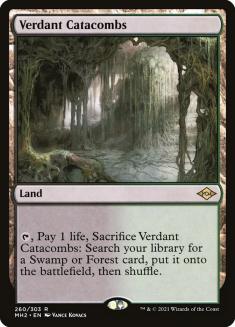
My opponent had already mulliganned to six, and I didn’t like my hand. There’s something to be said for being scared that your opponent will always have their best hand. Especially for a deck like Amulet Bloom, whose best hands are quite different from its mediocre hands, it’s fairly unlikely that you need to deal with their best draws. In reality, you probably have to deal with a hand that is somewhere down the middle. Given that, I still think this hand is close. In hindsight, I wish I had kept.
Why would I try to mulligan? What am I trying to mulligan into?
Ideally, it would be a hand with a discard spell, but my opponent might be trying to mulligan into a Leyline of Sanctity anyway. Since my opponent was already on six cards, it was unlikely that I’d be facing down his best draw. If that’s the case, my hand might actually end up being incredible. Liliana of the Veil might be able to put my opponent under a lot of pressure while Fulminator Mage will slow him down. Terminate or Maelstrom Pulse could take care of any topdecked Primeval Titans.
Obviously there’s an issue if I never see a third land, or even if my third land enters the battlefield tapped. There’s also the issue of my opponent having an Amulet of Vigor that I can’t deal with, which would force me to keep mana open to react to a potential Primeval Titan. It’s more likely that I have to ignore the threat of Primeval Titan if I ever want to cast my spells, but that means I’ll likely lose on the spot if he ever has it.
As I said, in hindsight I would keep the hand, and I would advise other people to keep hands like it, especially against an opponent on six cards. You are going to lose some games to their nut draws, but you can’t aggressively mulligan in the hopes that you can beat every single draw possible. In reality, you’ll be playing against a range of hands and can actually afford to keep a wider range of hands yourself.
How To Adapt Jund
Obviously it’s hostile out there for Jund, but I think we can do it. Most people tend to just switch from deck to deck, but I prefer tuning a deck whenever that’s possible and in this case I think it is. If it were a lost cause, it would be time to move on, but aside from G/R Tron, Amulet Bloom, and Burn (which are ultimately a small portion of Modern considering how many viable decks there are), I don’t mind playing against the field with Jund.
First of all, we need some land destruction maindeck. Fulminator Mage is fine against most decks and is what Yuuki Ichikawa inspired Brad Nelson to do, which earned him a 16th place finish at the Invitational. The Fulminator Mages basically need to be maindeck in order to have a reasonable chance of winning a match against the big mana decks.
Here’s where I am currently:
Creatures (13)
Planeswalkers (4)
Lands (25)
Spells (18)

This will likely not be my final decklist for Grand Prix Charlotte, but it’s definitely the shell I’ll be working with.
Scavenging Ooze seems to be getting worse, as the games are less about actually grinding people out and more about just being a combo breaker. Abrupt Decay also seems to be getting worse, although I fear that Storm is poised for a comeback.
With Abzan Collected Company and Grixis Delver likely shifting out of the format, Leyline of the Void is no longer necessary. There are still some Snapcaster Mage decks out there, so I still like having a card with graveyard interaction, but it needs to be something that gives me value. For example, if you’re using Jund Charm to counter half of a Snapcaster Mage, that’s not very efficient.
On the other hand, Nihil Spellbomb counters half of Snapcaster Mage on the cheap and for value. It’s basically perfect against decks that have graveyards I’d like to interact with but not enough to sideboard in multiple Leyline of the Voids. Scavenging Ooze is also pretty nice for what I’m trying to accomplish, but it’s often on the slow side. It’s rare that you’re able to eat their entire graveyard before it gets killed or kills them anyway.
I played with the Blood Moons last weekend, but I never drew them. They definitely would have OHKOed the Amulet Bloom deck I played against, and with some discard, they are quite good against G/R Tron.
Night of Souls’ Betrayal is phenomenal against a wide variety of decks in Modern. Splinter Twin, Affinity, most Collected Company decks, and even weirdos like Soul Sisters never want to see the card. There is some anti-synergy with Dark Confidant, but I side them out (or at least trim them) against a lot of decks. Against something like Splinter Twin or Collected Company, you will want to kill off your own Dark Confidant at some point anyway.
Overall, I like the shell, but definitely don’t like some things about it. For starters, the curve is a little high thanks to all the extra three-drops, so something probably has to give there. Secondly, I know the sideboard isn’t right, but it does have most of the cards I want to play with.
There are a few days before Grand Prix Charlotte, so hopefully I can smooth everything out before then. I enjoy playing Jund, I think it’s good against most things, and I think I can fix the matchups that aren’t great. The narrower the format becomes, the more dangerous Jund is because you can focus on the matchups that matter and mostly ignore the rest. Typically, if Jund has its sights set on you, you’re not going to want to play against it, so I’m going to do my best to nail down the metagame before the Grand Prix.
Of course, I could totally see myself doing something silly like audible to Grixis Control before the Grand Prix also.

